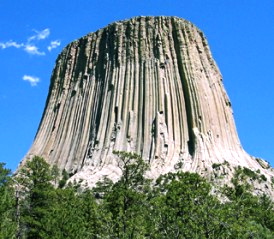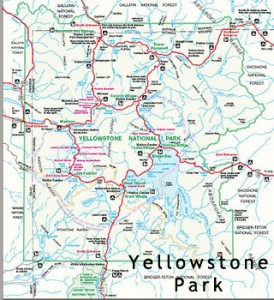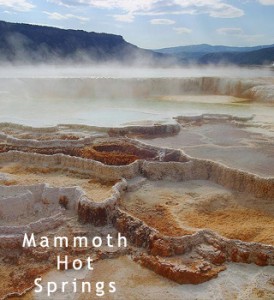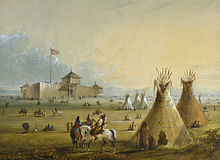Wyoming

“The History Of Yellowstone – The Discovery”
This Emmy Award winning TV documentary highlights the intriguing story behind the discovery of our nation’s first and oldest national park: Yellowstone. This unique theatre of nature is the largest active geyser basin in the world, and its mystical wonders have lured curious explorers here for centuries. The instrumental musical score composed and performed by Brian McBride won the prestigious Emmy Award for best music in September 2005, and was also honored as a 2005 National Telly Awards winner. The following clips are samples taken from the documentary. To listen to and/or purchase soundtrack (complete CD or individual MP3s), visit: http://www.mcbrideproductions.com
Timeline of Wyoming: 1700’s – 1800’s
 (1742-1743) Francois Louis Verendyne entered Wyoming, discovered Big Horn Mountains
(1742-1743) Francois Louis Verendyne entered Wyoming, discovered Big Horn Mountains- (1803) Louisiana Purchase completed, included present day Wyoming
- (1806) American John Colter discovered Yellowstone, named area “Colter’s Hell’; explored Teton Mountains
- (1812) Robert Stuart discovered South Pass through Rocky Mountains
- (1822) General William Ashley established trading post on Yellowstone River
- (1827) Ashley’s group took first wheeled vehicle, a four-pounder cannon, across South Pass
- (1830) Kit Carson arrived in Wyoming
- (1832) Capt. B. L. E. Bonneville led first wagons through South Pass; established Fort Bonneville
- (1833) Bonneville discovered oil near Wind River Mountains
- (1834) First permanent trading post, Ft. Laramie, established
 (1842) Fort Bridger established; Capt. Fremont led expedition to Wyoming, discovered Fremont Peak; Gold discovered near South Pass
(1842) Fort Bridger established; Capt. Fremont led expedition to Wyoming, discovered Fremont Peak; Gold discovered near South Pass- (1849) U. S. purchased Fort Laramie
- (1854) Grattan Massacre occurred near Fort Laramie
- (1867) Cheyenne founded; Transcontinental Railroad entered Wyoming
- (1868) Wyoming Territory created
- (1869) Women received right to vote
 (1872) Yellowstone Park became first national park
(1872) Yellowstone Park became first national park- (1877) Arapahoe Indians moved to Wind River Reservation
- (1885) Chinese Massacre occurred at Rock Springs
- (1890) Wyoming admitted into Union as 44th state
- (1897) First Cheyenne Frontier Days celebrated
 Wyoming (
Wyoming (![]() i/waɪˈoʊmɪŋ/) is a state in the mountain region of the Western United States. Wyoming is the 10th most extensive, but the least populous and the 2nd least densely populated of the 50 States. The western two thirds of the state is covered mostly with the mountain ranges and rangelands in the foothills of theEastern Rocky Mountains, while the eastern third of the state is high elevation prairie known as the High Plains. Cheyenne is the capital and the most populous city of Wyoming with a population of nearly 60,000 people within its city proper.
i/waɪˈoʊmɪŋ/) is a state in the mountain region of the Western United States. Wyoming is the 10th most extensive, but the least populous and the 2nd least densely populated of the 50 States. The western two thirds of the state is covered mostly with the mountain ranges and rangelands in the foothills of theEastern Rocky Mountains, while the eastern third of the state is high elevation prairie known as the High Plains. Cheyenne is the capital and the most populous city of Wyoming with a population of nearly 60,000 people within its city proper.
History
 Several American Indian groups originally inhabited the region now known as Wyoming. The Crow, Arapaho, Lakota, and Shoshone were but a few of the original inhabitants encountered when white explorers first entered the region. What is now southwestern Wyoming became a part of the Spanish Empire and later Mexican territory of Alta California, until it was ceded to the United States in 1848 at the end of the Mexican-American War. French-Canadian trappers from Québec and Montréal ventured into the state in the late 18th century, leaving French toponyms such as Téton, La Ramie, etc. John Colter, a member of the Lewis and Clark Expedition, itself guided by French Canadian Toussaint Charbonneau and his young Shoshone wife, Sacagawea, first described the region in 1807. At the time, his reports of the Yellowstone area were considered to be fictional. Robert Stuart and a party of five men returning from Astoria discovered South Pass in 1812. The Oregon Trail later followed that route. In 1850, Jim Bridger located what is now known as Bridger Pass, which the Union Pacific Railroad used in 1868—as did Interstate 80, in ninety years’ time. Bridger also explored Yellowstone and filed reports on the region that, like those of Colter, were largely regarded as tall tales at the time.
Several American Indian groups originally inhabited the region now known as Wyoming. The Crow, Arapaho, Lakota, and Shoshone were but a few of the original inhabitants encountered when white explorers first entered the region. What is now southwestern Wyoming became a part of the Spanish Empire and later Mexican territory of Alta California, until it was ceded to the United States in 1848 at the end of the Mexican-American War. French-Canadian trappers from Québec and Montréal ventured into the state in the late 18th century, leaving French toponyms such as Téton, La Ramie, etc. John Colter, a member of the Lewis and Clark Expedition, itself guided by French Canadian Toussaint Charbonneau and his young Shoshone wife, Sacagawea, first described the region in 1807. At the time, his reports of the Yellowstone area were considered to be fictional. Robert Stuart and a party of five men returning from Astoria discovered South Pass in 1812. The Oregon Trail later followed that route. In 1850, Jim Bridger located what is now known as Bridger Pass, which the Union Pacific Railroad used in 1868—as did Interstate 80, in ninety years’ time. Bridger also explored Yellowstone and filed reports on the region that, like those of Colter, were largely regarded as tall tales at the time.
The region had acquired the name Wyoming by 1865, when Representative J. M. Ashley of Ohio introduced a bill to Congress to provide a “temporary government for the territory of Wyoming“. The name Wyoming derives from the Munsee name xwé:wamənk, meaning “at the big river flat”, but it was also named after the Wyoming Valley in Pennsylvania, made famous by the 1809 poem Gertrude of Wyoming by Thomas Campbell.
After the Union Pacific Railroad had reached the town of Cheyenne in 1867, the region’s population began to grow steadily, and the federal government established the Wyoming Territory on July 25, 1868. Unlike mineral-rich Colorado, Wyoming lacked significant deposits of gold and silver, as well as Colorado’s subsequent population boom. However, South Pass City did experience a short-lived boom after the Carissa Mine began producing gold in 1867). Furthermore, copper was mined in some areas between the Sierra Madre Mountains and the Snowy Range near Grand Encampment.
Once government-sponsored expeditions to the Yellowstone country began, reports by Colter and Bridger, previously believed to be apocryphal, were found to be true. This led to the creation of Yellowstone National Park, which became the world’s first national park in 1872. Nearly all of Yellowstone National Park lies within the far northwestern borders of Wyoming.
 On December 10, 1869, territorial Gov. John Allen Campbell extended the right to vote to women, making Wyoming the first U.S. state to grant suffrage to women. In addition, Wyoming was also a pioneer in welcoming women into politics. Women first served on juries in Wyoming (Laramie in 1870); Wyoming had the first female court bailiff (Mary Atkinson, Laramie, in 1870); and the first female justice of the peace in the country (Esther Hobart Morris, South Pass City, in 1870). Also, in 1924, Wyoming became the first state to elect a female governor, Nellie Tayloe Ross, who took office in January 1925. (In fact, Wyoming and Texas both elected female governors at the same time, but Wyoming’s took office a few days before Texas’s.) Due to its civil-rights history, Wyoming’s state nickname is “The Equality State.”
On December 10, 1869, territorial Gov. John Allen Campbell extended the right to vote to women, making Wyoming the first U.S. state to grant suffrage to women. In addition, Wyoming was also a pioneer in welcoming women into politics. Women first served on juries in Wyoming (Laramie in 1870); Wyoming had the first female court bailiff (Mary Atkinson, Laramie, in 1870); and the first female justice of the peace in the country (Esther Hobart Morris, South Pass City, in 1870). Also, in 1924, Wyoming became the first state to elect a female governor, Nellie Tayloe Ross, who took office in January 1925. (In fact, Wyoming and Texas both elected female governors at the same time, but Wyoming’s took office a few days before Texas’s.) Due to its civil-rights history, Wyoming’s state nickname is “The Equality State.”
Wyoming’s constitution included women’s suffrage and a pioneering article on water rights. The United States admitted Wyoming into the Union as the 44th state on July 10, 1890.
Wyoming was the location of the Johnson County War of 1892, on which the controversial 1980 film Heaven’s Gate was based, which erupted between competing groups of cattle ranchers. The passage of the federal Homestead Act led to an influx of small ranchers. Arange war broke out when either or both of the groups chose violent conflict over commercial competition in the use of the public land.

